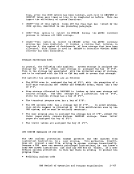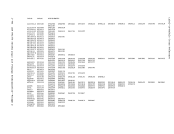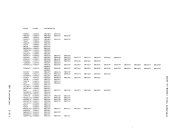Notes on using the as simulation routines: • CMS files are physically blocked in aDO-byte blocks, and logically
blocked according to a
file is not 4, the logical record length is equal to theDCBLRECL and
the file .ustalways be referenced with the same DCBLRECL, whetber or
not the file is blocked. If tbe filemode of the file is 4, tbe
logical record length is equal to theDCBBLKSI and the file aust always be referenced witb tbe same DCBBLKSI. • When writing CMS files with a filemode number other than four, the OS simulation routines deblock the output and write it on a disk in
unblocked records. The simulation routines delete each 4-byte block
descriptor word(BDW) and each 4-byte record descriptor word (RDW) of
variable length records. This makes tbeOS-created files compatible
withCMS-created files and CMS utilities. When CMS reads a eMS file
with a filemode number otber than four,CMS blocks the record input
as specifies and restores theBDW and RDi control words of variable
length records.• If the CMS filemode number is four, CMS does not unblock or delete tiuws or HDWs on output. CMS assumes on input that the file is
blocked as specified and that variable length records contain block
descriptor words and record descriptor words.
To set the READ/WRITE
FILEDEF command must
option.
pointers for a file at tbe end of the file, a
be issued for the file specifying theMeD • A file is erased and a new one created if the file is opened and all
the following conditions exist:
TheOUTPUT or OUTIN option of OPEN is specified.
TheTYPE option of OPEN is not J.
The dataset organization option of tbeDCE is not direct access or
partiticned.
A FILEDEF command has not been issued for data set specifying theMOD option. • The results are unpredictable if two DCBs read and write to the same
data set at the sametime. fLO!: The module DMSACC gets control first wben you
invoke tbeACCESS command. DMSACC verifies parameter list validity and
sets the necessary internal flags forlatpr use. If the disk you access
specifies a target mode of anotber disk currently accessed,DMSACC calls DMSALU to clear all pertinent information in the old active disk table. DMSACC then calls DMSACF to bring in the user file directory of the
disk. As soon asDMSACF gets control, DMSACF calls DMSACM to read in
the master file directory of the disk.Once DMSACM reads the label cf
the disk, and determines that it is anOS disk, DMSACM calls DMSROS (ROSACC) to complete the access of the OS disk. Upon returning from DMSROS, DMSACM returns immediately to DMSACF, bypassing the master file
directory logic forCMS disks. DMSACF then cbecks to determine if tbe
accessed disk is anOS disk. If it is an as disk, DMSACF returns
immediately toDMSACC, bypassing all the user file directory logiC for OS disks. DMSACC checks to determine if the accessed disk is an OS 2-130 IBM VM/370 System Logic and Program Determination--Volume 2
blocked according to a
file is not 4, the logical record length is equal to the
the file .ust
not the file is blocked. If tbe filemode of the file is 4, tbe
logical record length is equal to the
unblocked records. The simulation routines delete each 4-byte block
descriptor word
variable length records. This makes tbe
with
with a filemode number otber than four,
as specifies and restores the
length records.
blocked as specified and that variable length records contain block
descriptor words and record descriptor words.
To set the READ/WRITE
FILEDEF command must
option.
pointers for a file at tbe end of the file, a
be issued for the file specifying the
the following conditions exist:
The
The
The dataset organization option of tbe
partiticned.
A FILEDEF command has not been issued for data set specifying the
data set at the same
invoke tbe
sets the necessary internal flags for
specifies a target mode of anotber disk currently accessed,
disk. As soon as
the master file directory of the disk.
the disk, and determines that it is an
directory logic for
accessed disk is an
immediately to























































































































































































































































































